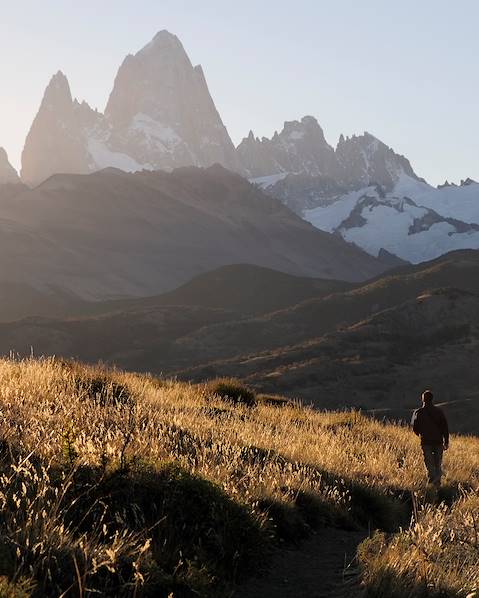Argentina, a country that is around 11 times bigger than the UK, stretches 2,360 miles from the sub-tropical north to the sub-Antarctic south. If you’re travelling around the country, it’s safe to say there are some epic journeys in store. Fortunately, Argentina has a well-developed transport infrastructure, making travel easy and comfortable. Travelling by road is best for appreciating the country’s scale and scenery but domestic flights can save a day (or more) for those short on time. The inter-city bus network is extensive but it’s worth considering car rental to explore more remote areas. And cosmopolitan capital Buenos Aires offers plentiful public transport, including South America’s first underground system. Whether you choose bus, plane, car, train, boat or bike, plan your best route with our guide to transport in Argentina.
By Bus
Buses can be a great way to get around in Argentina; they're cost-effective, comfortable and the road network is in good condition. Local buses in Buenos Aires (known as colectivos) use dedicated bus lanes, while long-distance buses (known as micros) are mostly modern and reliable, with air-conditioning, toilets and reclining seats. Snack boxes and even hot meals are often included in the fare, though they vary in quality. Ear plugs, an eye mask and layers for the sometimes glacial air-con are highly recommended. There are hundreds of regional operators and a few, such as TAC and Cruz del Sur, that run nationwide. To give you an idea of how long journeys can last, a bus ride from Buenos Aires to UshuaÏa will take more than 40 hours, so many travellers find it’s best to use buses for short to medium distances.
By Plane
Flying is the fastest way to get around the country. It's not the cheapest form of transport in Argentina, but it’s certainly a time saver (for example, the flight time between Buenos Aires and UshuaÏa is only three hours). Aerolineas Argentinas is the national airline, with the biggest destination network. Another popular carrier is LAN – a Chilean company with an Argentine subsidiary (LAN Argentina) – which flies to the country’s major tourist hubs. LATAM has flights to several Argentine cities and to neighbouring countries, while air force operated LADE flies to popular spots such as Bariloche and Ushuaia. Availability can be limited, especially during the holidays, but you can leave the admin to our travel specialists who are experts at bagging the best seats and rates going.
By Train
Although Subte, Buenos Aires’ excellent underground system, is a cost-effective and quick way of exploring the sprawling capital, Argentina’s wider rail network is rather neglected, with only a handful of long-distance lines in operation. While rail may not be the first choice for traversing the country, there are some excellent tourist trains that are well worth the ticket price. La Trochita, the Old Patagonian Express from Esquel, and the Tren a las Nubes – one of the highest railways in the world – are three especially scenic options.
By Car
Renting a car gives you the freedom to explore places at your leisure and get off the beaten track. It can be a particularly good way to explore regions such as Patagonia and the national parks where public transport is limited. While the country’s major roads are mostly in good condition, many rural routes are unpaved and dotted with potholes, so do take care. Rental cars and fuel tend to be more expensive than in Europe and North America, and if you’re planning to cross the border, you’ll need to ensure this is covered in the hire contract and by your insurance. Again, our experts are on hand to help arrange rental, so all you need to worry about is which of Argentina’s amazing places to include in your road trip.
By Taxi
Taxis are inexpensive and plentiful in Buenos Aires and other major towns and can be a convenient way to get around. If you hail one on the street, make sure the driver uses the meter, or agree the fare upfront. Minicabs are known as remises and charge fixed rates. Those in a group may find hiring a taxi a cost-effective and comfortable way of embarking on a day trip. Uber also operates in the capital.
By Boat
There are relatively few opportunities to travel by boat in Argentina, aside from ferry crossings and tourist trips. Popular pleasure boats operate in Parque Nacional Iguazú, in Patagonia’s Parque Nacional Los Glaciares, and around the picturesque delta of Tigre, northwest of the capital. Daily ferries cross from Buenos Aires to Montevideo and Colonia del Sacramento in Uruguay, and from Patagonia into Chile via the Magellan Strait.
By Bike
Bike hire and cycling tours are commonplace in Argentina’s cities and towns. Buenos Aires has an extensive network of cycling lanes and a free bike-sharing scheme called EcoBici, and other cities are improving their cycling infrastructure. Keen cyclists can also take on the popular RN-40 by mountain bike or the easier Seven Lakes Route in Argentina’s beautiful Lake District.
If you need help planning transport in Argentina, contact our expert team who can help to arrange your tailored trip. Argentina awaits.
















